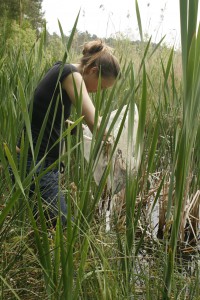
September 16, 2015, by Emma Thorne
We’re going on a spider hunt…
The weather has taken on a decidedly autumnal feel, the nights are drawing in and to a certain eight-legged mini beast seeking food and a mate your home is starting to look like a cosy haven.
It’s that time of the year when spider sightings in the home are at their peak and social media news feeds are awash with horror stories of people’s discoveries of huge specimens complete with gruesome images guaranteed to strike fear into the heart of every arachnophobe.
BBC Online reported this week how one company is aiming to cash in on people’s aversion to the creepy-crawlies by offering a spider-proof shed. With a price-tag of £1,999, the shed is air-tight and lined with repellent paper and is even painted blue, a colour which the company Tiger Sheds claims is “proven to repel spiders.”
However, the University’s resident arachnid expert Dr Sara Goodacre who runs the Spider Lab in the School of Life Sciences is not convinced about idea of a shed aimed to keep out these prolific garden dwellers.
While insecticide sprays might be a more effective way of dealing with unwanted intruders in your shed, trapping them and releasing them back into the garden would be a far more humane way of dealing with them, she argues.
She told the BBC that arachnophobia is a “learned” behaviour and can be dealt with psychologically. “My best advice is, when you see a spider in your home, or shed, give it a name,” says Dr Goodacre. “When we find one at home, we always call it Christopher. It changes the way you view it. Spiders get a little bit less scary if they have a name.”
While most people are preoccupied with how to avoid spiders this season, Dr Goodacre is this week embarking on an adventure aimed at bringing her face to face with one of the world’s most unusual spiders.
She will be joining a research collaborator in the Czech Republic to go on a spider hunt in the Krkonoše mountains where, under rocks, the elusive spider from the Cybaeus family can be found. It’s a close cousin of Argyroneta — the only spider on the planet that lives under water. The name Argyroneta comes from the Greek words meaning ‘spinner of silver’, reflecting the fact that these fascinating arachnids spin a silvery bell using silk and live in this bell under water.
Dr Goodacre said of the spider she is currently searching for: “It’s not big – but its beautifully marbled in colour with slightly striped legs. It’s also very elusive, hiding under particular rocks and stones. All spiders are venomous – just not to humans – so this one uses its venom to eat creepy crawlies.
“You don’t need any specialist equipment to go spider hunting – just some patience and an idea of where and when to look.”
But you don’t need to travel to the Czech Republic to see one of these amazing creatures. Relatives of it can be found closer to home in local nature reserves like Attenborough in Nottingham — if you dare to go on a spider hunt of your own.
No comments yet, fill out a comment to be the first


Leave a Reply